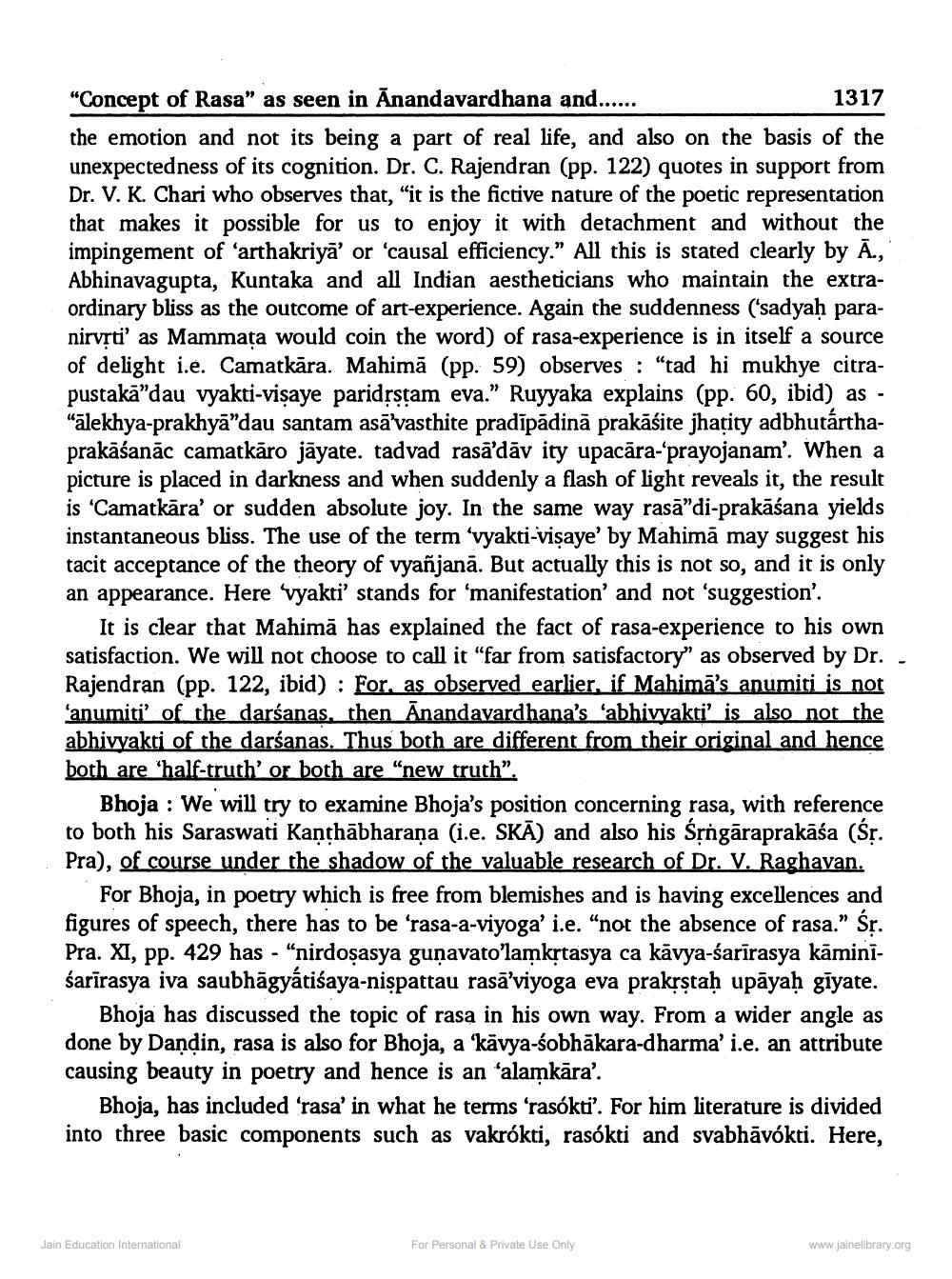________________
"Concept of Rasa" as seen in Anandavardhana and......
1317 the emotion and not its being a part of real life, and also on the basis of the unexpectedness of its cognition. Dr. C. Rajendran (pp. 122) quotes in support from Dr. V. K. Chari who observes that, “it is the fictive nature of the poetic representation that makes it possible for us to enjoy it with detachment and without the impingement of arthakriya' or 'causal efficiency." All this is stated clearly by A., Abhinavagupta, Kuntaka and all Indian aestheticians who maintain the extraordinary bliss as the outcome of art-experience. Again the suddenness ('sadyah paranirvrti' as Mammata would coin the word) of rasa-experience is in itself a source of delight i.e. Camatkāra. Mahimā (pp. 59) observes : “tad hi mukhye citrapustaka”dau vyakti-visaye paridrstam eva." Ruyyaka explains (pp. 60, ibid) as - "ālekhya-prakhyā”dau santam asā'vasthite pradīpādinā prakāśite jhasity adbhutárthaprakāśanāc camatkāro jāyate. tadvad rasa'dāv ity upacara-prayojanam'. When a picture is placed in darkness and when suddenly a flash of light reveals it, the result is 'Camatkāra' or sudden absolute joy. In the same way rasā"di-prakāśana yields instantaneous bliss. The use of the term 'vyakti-visaye' by Mahimā may suggest his tacit acceptance of the theory of vyañjanā. But actually this is not so, and it is only an appearance. Here vyakti' stands for 'manifestation' and not 'suggestion'.
It is clear that Mahimā has explained the fact of rasa-experience to his own satisfaction. We will not choose to call it "far from satisfactory" as observed by Dr. . Rajendran (pp. 122, ibid) : For, as observed earlier, if Mahimā's anumiti is not 'anumiti' of the darśanas, then Anandavardhana's 'abhivvakti' is also not the abhivvakti of the darśanas. Thus both are different from their original and hence both are 'half-truth' or both are “new truth”.
Bhoja : We will try to examine Bhoja's position concerning rasa, with reference to both his Saraswati Kanthābharana (i.e. SKĀ) and also his Sțngāraprakāśa (Sr. Pra), of course under the shadow of the valuable research of Dr. V. Raghavan.
For Bhoja, in poetry which is free from blemishes and is having excellences and figures of speech, there has to be 'rasa-a-viyoga' i.e. “not the absence of rasa." Sr. Pra. XI, pp. 429 has - "nirdosasya gunavato'lamkrtasya ca kävya-śarīrasya kāminiśarīrasya iva saubhāgyátiśaya-nispattau rasā’viyoga eva prakrstaḥ upāyaḥ gīyate.
Bhoja has discussed the topic of rasa in his own way. From a wider angle as done by Dandin, rasa is also for Bhoja, a 'kávya-sobhākara-dharma' causing beauty in poetry and hence is an 'alamkāra'.
Bhoja, has included 'rasa' in what he terms 'rasókti'. For him literature is divided into three basic components such as vakrókti, rasókti and svabhāvokti. Here,
Jain Education International
For Personal & Private Use Only
www.jainelibrary.org




